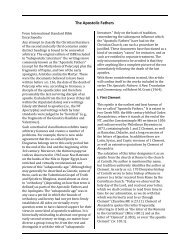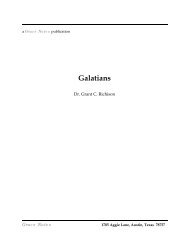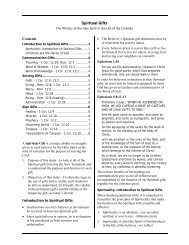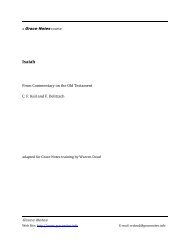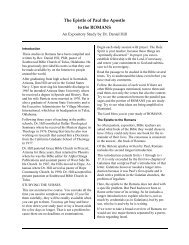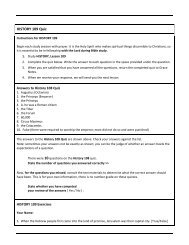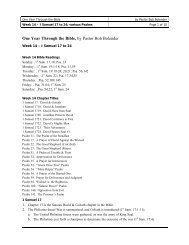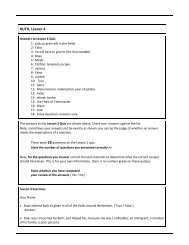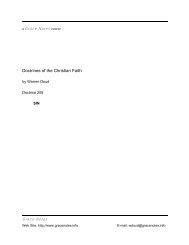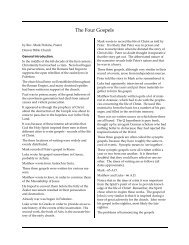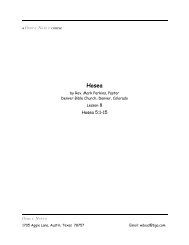Song of Solomon - Grace Notes
Song of Solomon - Grace Notes
Song of Solomon - Grace Notes
You also want an ePaper? Increase the reach of your titles
YUMPU automatically turns print PDFs into web optimized ePapers that Google loves.
SONG OF SOLOMON Page 51By C. F. Keil and F. Delitzscha <strong>Grace</strong> <strong>Notes</strong> studytamashy, to walk, then, to contemplate).Lebanon is the name <strong>of</strong> the Alpine range whichlies in the N.-W. <strong>of</strong> the Holy Land, and stretchesabove 20 (German) miles from the Leontes(Nahr el-Kasmîe) northwards to the Eleutheros(Nahr el-Kebîr). The other three names herefound refer to the Anti-Libanus separated fromthe Lebanon by the Coelo-Syrian valley, andstretching from the Banis northwards to theplain <strong>of</strong> Hamâth.Amana denotes that range <strong>of</strong> the Anti-Libanusfrom which the springs <strong>of</strong> the river Amanaissue, one <strong>of</strong> the two rivers which the Syriancaptain (2 Kings 5:12) named as better than allthe waters <strong>of</strong> Israel. These are the Amana andPharpar, i.e., the Baradâ and A’wadsh; to theunion <strong>of</strong> the Baradâ (called by the GreeksChrysorrhoas, i.e., “golden stream”) with theFeidshe, the environs <strong>of</strong> Damascus owe theirghuwdat, their paradisaical beauty.Hermon (from רַ ם ,חָ to cut <strong>of</strong>; cf. Arab. kharomand makhrim, the steep projection <strong>of</strong> amountain) is the most southern peak <strong>of</strong> theAnti-Libanus chain, the l<strong>of</strong>ty mountains (about10,000 feet above the level <strong>of</strong> the sea) whichform the north-eastern border <strong>of</strong> Palestine, andfrom which the springs <strong>of</strong> the Jordan take theirrise.Another section <strong>of</strong> the Anti-Libanus range iscalled Senir, not Shenir. The name, in all thethree places where it occurs (Deut. 3:9; 1Chron. 5:23), is, in accordance with tradition, tobe written with Sin. The Onkelos Targum writesטורא דמסרי paraphrases, the Jerusalem ;סריוןputrid, (the mountain whose fruits become פירויviz., on account <strong>of</strong> their superabundance); theשהוא שובא הניר otherwise: Midrash explains(the mountain which resists being broken up bythe plough),—everywhere the writing <strong>of</strong> theword with the letter Sin is supposed. Accordingto Deut. 3:9, this was the Amorite name <strong>of</strong>Hermon. The expression then denotes that theAmorites called Hermon—i.e., the Anti-Libanusrange, for they gave the name <strong>of</strong> a part to thewhole range—by the name Senîr; Abulfeda usesArab. snîr as the name <strong>of</strong> the part to the north <strong>of</strong>Damascus, with which the statement <strong>of</strong>Schwarz (Das h. Land, p. 33) agrees, that theHermon (Anti-Libanus) to the north-west <strong>of</strong>Damascus is called Senîr.panthers, to the present day inhabit the ,נְׁ מַ רִ יםclefts and defiles <strong>of</strong> the Lebanon, and <strong>of</strong> theAnti-Libanus running parallel to it; whereaslions have now altogether disappeared from thecountries <strong>of</strong> the Mediterranean. In <strong>Solomon</strong>’stime they were to be met with in the lurkingplaces<strong>of</strong> the Jordan valley, and yet morefrequently in the remote districts <strong>of</strong> thenorthern Alpine chains. From the heights <strong>of</strong>these Alps <strong>Solomon</strong> says Shulamith shall alonewith him look down from where the lions andpanthers dwell. Near these beasts <strong>of</strong> prey, andyet inaccessible by them, shall she enjoy theprospect <strong>of</strong> the extensive pleasant land whichwas subject to the sceptre <strong>of</strong> him who held hersafe on these cliffs, and accompanied her overthese giddy heights. If “mountain <strong>of</strong> myrrh,” soalso “the top <strong>of</strong> Amana” is not withoutsubordinate reference. Amana, proceeding fromthe primary idea <strong>of</strong> firmness and verification,signifies fidelity and the faithful covenant as itis established between God and thecongregation, for He betrothes it to Himself(“in faithfulness”), Hos. 2:22 [20]; the באמונהcongregation <strong>of</strong> which the apostle (Eph. 5:27)says the same as is here said by <strong>Solomon</strong> <strong>of</strong>Shulamith. Here for the first time he calls herloq., for that, according to the usus ;כַ לָ תִ י not ,כַ לָ הwould mean “my daughter-in-law.” Accordingly,it appears that the idea <strong>of</strong> “daughter-in-law” isthe primary, and that <strong>of</strong> “bride” the secondaryone. לָ ה ,כַ which is = לּולָ ה ,כְׁ as לָ ה ,חַ a cake, is =,כְׁ לּולות (cf. that which is pierced through ,חֲ לּולָ הbeing espoused; Jer. 2:2), appears to mean (cf.what was said regarding חָ תָ ן under 3:11b) herwho is comprehended with the family intowhich, leaving her parents’ house, she enters;not her who is embraced = crowned with agarland (cf. Arab. qkll, to be garlanded; tēklîl,garlanding; iklil, Syr. klilo, a wreath), or her whois brought to completion (cf. the verb, Ezek.27:4, 11), i.e., has reached the goal <strong>of</strong> her



